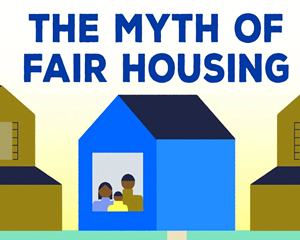On October 21st, 1909, 125 residents of an affluent Minneapolis neighborhood approached William Simpson, who'd just bought a plot in the area, and told him to leave.
1909年10月21日,明尼阿波利斯一个富裕社区的125名居民找到了刚在该地区买了一块地的威廉·辛普森,叫他离开。
The Simpsons would be the second Black family in the otherwise white neighborhood, where they intended to build a home.
辛普森一家将是这个白人社区的第二个黑人家庭,他们打算在这里建一个家。
When the Simpsons refused offers to buy them out, their neighbors tried blocking their home's construction.
辛普森一家拒绝出售他们的土地,于是邻居试图阻止他们盖房子。
They finally moved into their house, but the incident had a ripple effect.
他们最终搬进了自己的房子,但这件事产生了连锁反应。
Just a few months after the mob harassed the Simpsons, the first racially restrictive covenant was put into place in Minneapolis.
就在暴民骚扰辛普森一家几个月后,第一份种族限制公约在明尼阿波利斯生效。
Covenants are agreements in property deeds that are intended to regulate how the property is to be used.
公约是物业契约中的协议,旨在规范物业的使用方式。
Beginning in the mid-1800s, people in the United States and elsewhere began employing them in a new way: specifically, to racially restrict properties.
从19世纪中期开始,美国和各地的人们开始以一种新的方式利用契约:具体来说,是为了种族限制财产。
They wrote clauses into deeds that were meant to prevent all future owners from selling or leasing to certain racial and ethnic groups, especially Black people.
他们在契约中写了一些条款,旨在阻止所有未来的所有者向特定的种族和民族群体出售或出租房屋,尤其是黑人。
Between 1920 and 1950, these racial covenants spread like wildfire throughout the US, making cities more segregated and the suburbs more restricted.
在1920年到1950年之间,这些种族契约像野火一样在美国蔓延开来,使得城市更加隔离,郊区更加限制。
In the county encompassing Minneapolis, racial covenants eventually appeared on the deeds to more than 25,000 homes.
在明尼阿波里斯县,种族契约最终出现在超过2.5万户家庭的房契上。
Not only was this legal, but the US Federal Housing Administration promoted racial covenants in their underwriting manual.
这不仅是合法的,而且美国联邦住房管理局还在其承保手册中提倡种族契约。
While constructing new homes, real estate developers began racially restricting them from the outset.
在建造新房的过程中,房地产开发商从一开始就对他们进行种族限制。
Developments were planned as dream communities for American families -- but for white people only.
这些项目被规划为美国家庭的梦想社区--但只为白人。
In 1947, one company began building what became widely recognized as the prototype of the postwar American suburb: Levittown, New York.
1947年,一家公司开始建造一个被广泛认为是战后美国郊区原型的地方:纽约的莱维敦。
It was a community of more than 17,000 identical homes. They cost around $7,000 each and were intended to be affordable for returning World War II veterans.
这是一个拥有1.7万多栋相同房屋的社区。它们的价格在7000美元左右,原本是打算让归来的二战老兵负担得起的。
But, according to Levittown's racial covenants, none of the houses could "be used or occupied by any person other than members of the Caucasian race," with one exception: servants.
但是,根据莱维敦的种族契约,这些房子“不能被白人以外的任何人使用或居住”,只有一个例外:仆人。
Between 1950 and 1970, the population of the American suburbs nearly doubled as white people flocked to more racially homogenous areas in a phenomenon known as "white flight."
1950年至1970年间,美国郊区的人口几乎翻了一番,因为白人成群地涌向种族更单一的地区,这种现象被称为“白人迁徙”。
The suburbs spread, replacing native ecosystems with miles of pavement and water-guzzling lawns. And their diffuse layout necessitated car travel.
郊区的扩张,用绵延数英里的人行道和耗水的草坪取代了当地的生态系统。而且他们漫无目的的布局使汽车旅行成为必要。
American automobile production quadrupled between 1946 and 1955, cementing the nation's dependence on cars.
1946年至1955年间,美国汽车产量翻了两番,巩固了国家对汽车的依赖。
Federal programs like the G.I. Bill offered American veterans favorable lending rates for buying homes.
像《退伍军人福利法案》这样的联邦计划,为美国退伍军人购买住房提供优惠贷款利率。
But it was difficult for people of color to take advantage of such resources. Racial covenants restricted them from certain neighborhoods.
但是有色人种很难利用这些资源。种族契约限制他们进入某些社区。
And, at the same time, government programs labelled neighborhoods of color bad investments and often refused to insure mortgages in those areas.
与此同时,政府项目将有色人种社区列为不良投资,并经常拒绝为这些地区的抵押贷款提供担保。

Therefore, banks usually wouldn't lend money to people purchasing property in neighborhoods of color -- a practice that became known as redlining.
因此,银行通常不会借钱给在有色人种社区购买房产的人--这种做法后来被称为“划红线”。
So, instead of owning homes that increased in value over time, creating wealth that could be passed to future generations, many people of color were forced to spend their income on rent.
因此,许多有色人种被迫将收入花在房租上,而不是拥有随时间增值的房屋,创造可以传递给后代的财富。
And even when they were able to buy property, their home's value was less likely to increase.
而且,即使他们有能力购买房产,他们的房子的价值也不太可能增加。
The suburbs boasted cul-de-sacs and dead ends that minimized traffic.
郊区有许多死胡同,使交通流量最小化。
Meanwhile, city planners often identified redlined neighborhoods as inexpensive areas for industrial development.
与此同时,城市规划者经常将被划上红线的社区视为工业发展的廉价区。
So, the massive freeway projects of the mid-20th century disproportionately cut through redlined neighborhoods, accompanied by heavy industry and pollution.
因此,20世纪中期的大规模高速公路项目不成比例地穿过了被划上红线的社区,伴随着重工业和污染。
As a result, many neighborhoods of color experience higher rates of drinking water contamination, asthma, and other health issues.
因此,许多有色社区的饮用水污染、哮喘和其他健康问题的发病率更高。
People targeted by racial covenants increasingly challenged them in court and, in 1968, they were finally banned under the Fair Housing Act.
受到种族契约攻击的人越来越多地在法庭上对它们提出质疑,1968年,这些契约最终在《公平住房法》下被禁止。
But the damage had been done. Racial covenants concentrated wealth and amenities in white neighborhoods and depressed the conditions and home values in neighborhoods of color.
但损害已经造成。种族契约将财富和便利设施集中在白人社区,压低了有色社区的条件和家庭价值。
As of 2020, about 74% of white families in the US owned their homes, while about 44% of Black families did.
截至2020年,美国约74%的白人家庭拥有自己的房子,而黑人家庭这一数字则为大约44%。
That gap is greatest in Minnesota's Twin Cities. Across the country, neighborhoods remain segregated and 90% of all suburban counties are predominantly white.
这一差距在明尼苏达州的双子城最为明显。在全国范围内,社区仍然是隔离的,90%的郊区县主要是白人。
Some landlords, real estate agents, and lenders still discriminate against people based on race
一些房东、房地产中介和贷款机构仍然基于种族歧视人们,
rejecting them, steering them to and away from certain neighborhoods, or providing inaccessibly high interest rates.
拒绝他们,引导他们进或出某些社区,或提供难以触及的高利率。
Gentrification and exclusionary zoning practices also still displace and keep people of color out of certain neighborhoods.
中产阶级化和排他性分区的做法也仍在取代和阻止有色人种进入某些社区。
Racial covenants are now illegal. But they can still be seen on many housing deeds.
种族契约现在是非法的。但仍然可以在许多住房契约上看到。
The legacy of racial covenants is etched across the pristine lawns of the American suburbs.
种族契约的遗产在美国郊区的原始草坪上蚀刻着。
It's a footnote in the demographic divides of every city. And it's one of the insidious architects of the hidden inequalities that shape our world.
这是每个城市人口划分的一个注脚。它是塑造我们世界的隐性不平等的阴险建筑之一。













